Funeral of Queen Elizabeth The Queen Mother
The public funeral of Queen Elizabeth The Queen Mother occurred on Tuesday, 9 April 2002 in Westminster Abbey in London, following her death on 30 March 2002 at the age of 101.
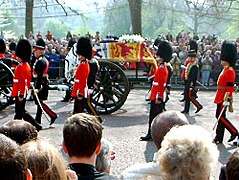 | |
| Date | Tuesday, 9 April 2002 9:48–13:50 |
|---|---|
| Location | Westminster Abbey, London (official ceremony) St George's Chapel, Windsor Castle (resting place) |
| Participants | British Royal Family |
Background
The Queen Mother had been suffering from a persistent cold which she caught during Christmas 2001. She was bedridden at Sandringham after her final public engagement on 22 November 2001, when she attended the recommissioning of HMS Ark Royal.[2] However, despite missing many other scheduled events—such as the 100th birthday celebrations of Princess Alice, Duchess of Gloucester, on 12 December 2001;[3] the annual luncheon of the Women's Institutes, of which she was President, on 23 January 2002,[4] and traditional church services at Sandringham[5]—she was determined to attend the funeral of her younger daughter Princess Margaret. On 13 February she slipped in her sitting room at Sandringham, causing considerable concern to her daughter, the Queen, and the rest of the royal family, but she travelled to Windsor by helicopter the following day. She attended the funeral on 15 February in a people carrier with blacked–out windows,[6][7] (which had recently been used by Margaret)[8][9] shielded from the press according to her wishes so that no photographs of her in a wheelchair could be taken. She then returned to Royal Lodge. On 5 March 2002 she attended lunch at the annual lawn party of the Eton Beagles, and watched the Cheltenham races on television; but her health rapidly deteriorated during her last weeks after retreating to the Lodge for the final time.[10] She weakened further throughout March 2002, and died on 30 March (Easter Saturday), at 15:15 GMT, with her surviving daughter, Queen Elizabeth II, at her bedside.[11]
The Queen Mother's body lay at the altar of the Royal Chapel of All Saints near Royal Lodge before being taken to London for her lying in state and funeral.[12][13] At one point, her four grandsons Prince Charles, Prince Andrew, Prince Edward and Viscount Linley mounted the guard as a mark of respect—an honour similar to the Vigil of the Princes at the lying in state of King George V.[14][15] An estimated 200,000 people over three days filed past as she lay in state in Westminster Hall at the Palace of Westminster.[16][17]
The published order of service included as a preface the verse beginning "You can shed tears that she is gone" (attributed to an anonymous author) selected by the Queen. The verse became widely popular after the funeral, and was later revealed to be based on a poem written some 20 years earlier by David Harkins, an aspiring artist from Carlisle.[18][19] Andrew Motion who had previously written poems for the wedding of Prince Edward, the Queen Mother's 100th birthday, and the death of Princess Margaret, released an elegy in honour of the Queen Mother.[20] Both the Queen and the Prince of Wales paid tribute to the Queen Mother in separate television broadcasts.[21]
The funeral
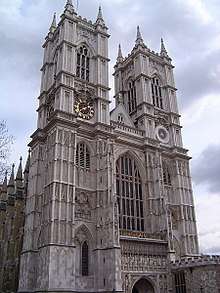
The funeral was held in London. It started at 9:48 am on 9 April 2002, when the tenor bell of Westminster Abbey sounded 101 times, each chime representing a year that the Queen Mother had lived. At 11:18 am the coffin was carried from Westminster Hall in the Palace of Westminster where the Queen Mother's coffin – draped in her personal standard and with her crown resting on a cushion – had been lying in state on a six-foot (1.8 m) catafalque. The coffin was then taken to the Abbey, about 300 metres away, accompanied by a massed pipe band of 128 musicians drawn from 13 British and Commonwealth regiments.[22][23] The following members of the Royal Family followed the procession: The Duke of Edinburgh, Prince Charles, Prince Andrew, Princess Anne, Prince Edward, Prince William, Prince Harry, Viscount Linley, Peter Phillips, Daniel Chatto, The Duke of Gloucester, The Duke of Kent, Prince Michael of Kent and Timothy Laurence. Also accompanying the royal family were members of the Bowes-Lyon family and some of her senior household staff.[24] During the funeral the Union Flag flew at half mast over Buckingham Palace, and her own personal royal standard at Clarence House (the Queen Mother's official London residence since 1952).[25] After the funeral, the Queen Mother's personal standard was lowered for the final time.
The doors of Westminster Abbey were first opened at 9:45 am, and the first of the 2,200 guests arrived; most of the guests were in their seats by 10:30 am. Five minutes later, VIPs and heads of state began arriving via the Great West Door. At 10:40 am, the bearer party of the Irish Guards arrived at Westminster Hall, positioning themselves outside the North Door. A guard of honour was mounted by the Nijmegen Company of the Grenadier Guards, and the members of the Royal Family walking in the funeral procession arrived from Buckingham Palace and St. James's Palace. Royalty who were not in the procession arrived at the Grand Entrance of Buckingham Palace.
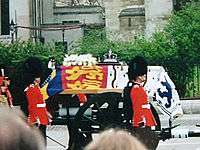
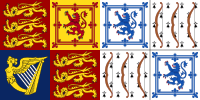
The procession lasted from 11:00 am until 11:16 am.[26] Members of the Royal Family were chauffeured to the Abbey's Great West Door at 11:05 am to be received by the Dean of Westminster (Wesley Carr) and Chapter, and conducted to St. George's Chapel. Two minutes later, the visiting clergy participating in the service, such as the then Archbishop of Canterbury George Carey, processed along the centre aisle of the Abbey. The Queen left Buckingham Palace in the royal Rolls Royce at 11:12 am, arriving with her entourage at the Great West Door four minutes later. She and others, including Lady Sarah and Daniel Chatto, Zara Phillips, Timothy Laurence, Viscountess Linley, Princess Beatrice and Princess Eugenie then walked down the Centre Aisle to their seats in the Lantern. The funeral service began at 11:30 am, lasting about 50 minutes.
The funeral started with the choir singing the Funeral Sentences, composed by William Croft and Henry Purcell. The first lesson from Ecclesiastes, chapter 12, verses 1–7, was read by Dr David Hope, the Archbishop of York, and the second lesson, from the Book of Revelation, chapter 7, verses 9–17, was read by Cardinal Cormac Murphy-O'Connor, the Archbishop of Westminster. The sermon was given by Dr George Carey, the Archbishop of Canterbury,[27] and a reading from The Pilgrim's Progress was given by the Reverend Anthony Burnham, the Moderator of The Free Churches Group. The Psalm was Psalm 121, sung to a setting by William McKie. The hymns were Immortal, Invisible, God Only Wise; words by Walter Chalmers Smith to the traditional Welsh tune St Denio, and Guide me, O thou great Redeemer, by William Williams to the tune Cwm Rhondda by John Hughes. The anthems were How lovely are they dwellings fair by Johannes Brahms and Holy is the true light by William Henry Harris. The service finished with the Last Post, the proclamation of the Queen Mother's styles and titles by the Garter King at Arms Peter Gwynn-Jones, Reveille and the National Anthem. The voluntary was the Prelude and Fugue in E flat, BWV552 by Johann Sebastian Bach, and the Abbey bells rang half-muffled to a peal of Stedman Caters of 5101 changes.[28][29][27]
At 12:25 pm, the bearer party lifted the coffin from the catafalque in the Abbey to the hearse outside the West Gate. The Queen and Duke of Edinburgh observed the departure of the coffin by road for Windsor, along with other members of the Royal Family. The car procession began at 12:35 pm, via Broad Sanctuary, the west side of Parliament Square, Whitehall, Horse Guards, Horse Guards Arch, The Mall, the south and west sides of Victoria Memorial, Constitution Hill, Wellington Arch, Hyde Park Corner, Queen Elizabeth Gate, South Carriage Drive, Queen's Gate, Great West Road and Datchet.[30][31]
The Queen and Duke then left the abbey by car for Buckingham Palace at 12:40 pm, followed by others in the processions three minutes later. The Queen arrived at the Palace five minutes later, and there was a lunch for dignitaries at 1:00 pm.
Interment
Queen Elizabeth was interred in the George VI Memorial Chapel next to her husband, King George VI, who had died 50 years previously. At the same time, the ashes of their daughter, Princess Margaret, who had died on 9 February 2002, were also interred in a private family service.[32]
Guests
Immediate family
- The Queen and The Duke of Edinburgh, The Queen Mother's daughter and her husband
- The Prince of Wales The Queen Mother's grandson
- Prince William of Wales, The Queen Mother's great-grandson
- Prince Henry of Wales, The Queen Mother's great-grandson
- The Princess Royal and Commodore Timothy Laurence, The Queen Mother's granddaughter and her husband
- Mr. Peter Phillips, The Queen Mother's great-grandson
- Miss Zara Phillips, The Queen Mother's great-granddaughter
- The Duke of York and Sarah, Duchess of York, The Queen Mother's grandson and his ex-wife
- Princess Beatrice of York, The Queen Mother's great-granddaughter
- Princess Eugenie of York, The Queen Mother's great-granddaughter
- The Earl and Countess of Wessex, The Queen Mother's grandson and his wife
- The Prince of Wales The Queen Mother's grandson
- The Princess Margaret, Countess of Snowdon's family:
- The Viscount and Viscountess Linley, The Queen Mother's grandson and his wife
- The Lady Sarah and Mr Daniel Chatto, The Queen Mother's granddaughter and her husband
Foreign royalty
Reigning royals
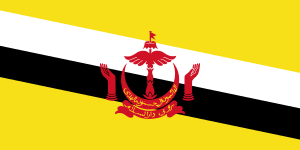





.svg.png)
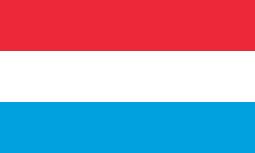
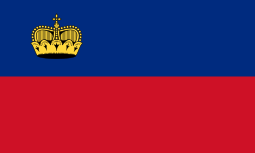

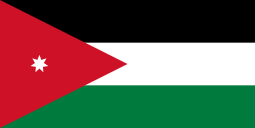
Non-reigning royals

.svg.png)
.svg.png)
.svg.png)
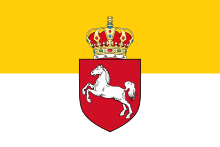
_crowned.svg.png)
Prime Ministers
- Tony Blair, Prime Minister of the United Kingdom, and Mrs. Blair
- Jean Chrétien, Prime Minister of Canada
- John Howard, Prime Minister of Australia
- Helen Clark, Prime Minister of New Zealand
- Sir Edward Heath, former Prime Minister of the United Kingdom
- The Lord Callaghan of Cardiff, former Prime Minister of the United Kingdom
- The Baroness Thatcher, former Prime Minister of the United Kingdom and Sir Denis Thatcher
- John Major, former Prime Minister of the United Kingdom and Dame Norma Major
Other dignitaries
- Laura Bush, First Lady of the United States of America
- William Stamps Farish III, United States Ambassador to the United Kingdom
- Anne Armstrong, former United States Ambassador to the United Kingdom
- Iain Duncan Smith, Leader of the Opposition, and Mrs. Duncan Smith
- The Lord Jenkins of Hillhead, politician
- The Lord St John of Fawsley, politician
- Stephen Byers, Secretary of State for Transport, Local Government and the Regions
- Margaret Beckett, Secretary of State for Environment, Food and Rural Affairs
- John Prescott, Deputy Prime Minister, and Mrs. Prescott
Source for mourners [33]
References
- Bates, Stephen (3 April 2002), "Piper's farewell for Queen Mother", The Guardian, retrieved 1 May 2009
- "Queen Mother 'ill with bug'", Yorkshire Post, 23 January 2002, retrieved 20 August 2013
- Vickers, Hugo (2005). Elizabeth, The Queen Mother. London: Hutchinson. p. 495. ISBN 0-09-180010-2.
- Queen Mother misses engagement, BBC, 23 January 2002, retrieved 20 August 2013
- Davies, Caroline (31 December 2001), Queen Mother misses third service, London: The Telegraph, retrieved 20 August 2013
- BBC News bulletin after Queen Mother dies, YouTube, 30 March 2002, retrieved 1 May 2009
- Queen Elizabeth The Queen Mother: Frailty fails to dim devotion to duty; Reaching old age., The Birmingham Post, 1 April 2002, retrieved 30 August 2013
- Vickers, p. 497
- Davies, Caroline (16 February 2002), Bell tolls for Margaret's final journey, London: The Telegraph, retrieved 22 September 2013
- Vickers, pp. 498–499
- "2002: Queen Mother dies". BBC. Retrieved 29 May 2018.
- "Gun salutes honour Queen Mother". The Guardian. Retrieved December 6, 2013.
- "The procession". BBC. Retrieved 25 May 2018.
- "Grandsons hold vigil as public files past", The Guardian, 9 April 2002, retrieved 29 June 2017
- Charles returns for second tribute, BBC News, 9 April 2002, retrieved 29 June 2017
- Lying-in-state, UK Parliament, retrieved 29 June 2017
- "Lying-in-state". BBC. Retrieved 25 May 2018.
- "'Mysterious origin' of funeral poem", BBC News, 11 April 2002. Retrieved 8 June 2015
- Matt Seaton, "The accidental laureate", The Guardian, 16 September 2002. Retrieved 8 June 2015
- "Motion's poem for Queen Mother". BBC. 9 April 2002. Retrieved 25 May 2018.
- "Queen Mother: Audio video coverage". BBC. 7 April 2002. Retrieved 25 May 2018.
- Alderson, Andrew; Lusher, Adam (7 April 2002). "Queen Mother's 'human side' seen in poems and hymns". www.telegraph.co.uk. London: Telegraph Media Group Limited. Retrieved 26 September 2014.
- "The funeral service". BBC. Retrieved 25 May 2018.
- "The procession: Who's who". BBC. Retrieved 25 May 2018.
- "Flag Queen Mother Tribute". Getty Images. 4 April 2002. Retrieved 25 May 2018.
- "The procession: The route". BBC. Retrieved 25 May 2018.
- "'She was strength, dignity and laughter'". BBC. 9 April 2002. Retrieved 25 May 2018.
- "Funeral service: The service". BBC. Retrieved 25 May 2018.
- "Funeral of Queen Elizabeth, the Queen Mother: Full text of the service held at Westminster Abbey". www.theguardian.com. Guardian News and Media Limited. 9 April 2002. Retrieved 25 September 2014.
- "The funeral: Windsor route". BBC. Retrieved 25 May 2018.
- "The committal". BBC. Retrieved 25 May 2018.
- "Queen Mother is laid to rest". BBC News. April 10, 2002. Retrieved 11 January 2017.
- "List of mourners". The Guardian. 9 April 2002. Retrieved 20 April 2019.
External links
| Wikimedia Commons has media related to Funeral of Queen Elizabeth, The Queen Mother. |
- BBC's full coverage
- "Funeral Timetable". London: "The Guardian". 9 April 2002. Retrieved 12 July 2013.
- List of mourners